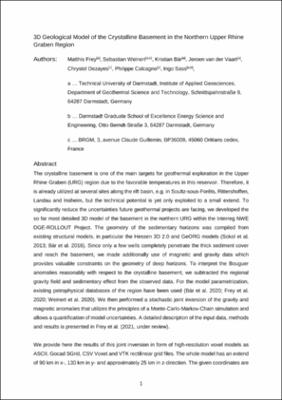| dc.contributor.author | Frey, Matthis | |
| dc.contributor.author | Weinert, Sebastian | |
| dc.contributor.author | Bär, Kristian | |
| dc.contributor.author | van der Vaart, Jeroen | |
| dc.contributor.author | Dezayes, Chrystel | |
| dc.contributor.author | Calcagno, Philippe | |
| dc.contributor.author | Sass, Ingo | |
| dc.date.accessioned | 2021-02-12T10:04:19Z | |
| dc.date.available | 2021-02-11T15:57:07Z | |
| dc.date.available | 2021-02-12T10:04:19Z | |
| dc.date.issued | 2021-02 | |
| dc.identifier.uri | https://tudatalib.ulb.tu-darmstadt.de/handle/tudatalib/2594.2 | |
| dc.identifier.uri | https://doi.org/10.48328/tudatalib-417.2 | |
| dc.description | The crystalline basement is one of the main targets for geothermal exploration in the Upper Rhine Graben (URG) region due to the favorable temperatures in this reservoir. Therefore, it is already utilized at several sites along the rift basin, e.g. in Soultz-sous-Forêts, Rittershoffen, Landau and Insheim, but the technical potential is yet only exploited to a small extend. To significantly reduce the uncertainties future geothermal projects are facing, we developed the so far most detailed 3D model of the basement in the northern URG within the Interreg NWE DGE-ROLLOUT Project. The geometry of the sedimentary horizons was compiled from existing structural models, in particular the Hessen 3D 2.0 and GeORG models (Sokol et al. 2013; Bär et al. 2016). Since only a few wells completely penetrate the thick sediment cover and reach the basement, we made additionally use of magnetic and gravity data which provides valuable constraints on the geometry of deep horizons. To interpret the Bouguer anomalies reasonably with respect to the crystalline basement, we subtracted the regional gravity field and sedimentary effect from the observed data. For the model parametrization, existing petrophysical databases of the region have been used (Bär et al. 2020; Frey et al. 2020; Weinert et al. 2020). We then performed a stochastic joint inversion of the gravity and magnetic anomalies that utilizes the principles of a Monte-Carlo-Markov-Chain simulation and allows a quantification of model uncertainties. A detailed description of the input data, methods and results is presented in Frey et al. (2021, in review).
We provide here the results of this joint inversion in form of high-resolution voxel models as ASCII, Gocad SGrid, CSV Voxet and VTK rectilinear grid files. The whole model has an extend of 90 km in x-, 130 km in y- and 26 km in z-direction. The given coordinates are in UTM Zone 32N and refer to the mid-point of each voxel. While the voxel size is constant in x- and y-direction (1km), it varies in z-direction (50m above sea level, below sea level the voxel height increases from approx. 500 at the top to approx. 1500 at the bottom). | en_US |
| dc.language.iso | en | en_US |
| dc.rights | Creative Commons Attribution 4.0 | |
| dc.rights.uri | https://creativecommons.org/licenses/by/4.0/ | |
| dc.subject | Northern Upper Rhine Graben | en_US |
| dc.subject | Geological 3D Modell | en_US |
| dc.subject | Gravimetry | en_US |
| dc.subject | Magnetics | en_US |
| dc.subject | Joint Inversion | en_US |
| dc.subject.classification | 314-01 Geologie, Ingenieurgeologie, Paläontologie | en_US |
| dc.subject.classification | 315-01 Physik des Erdkörpers | en_US |
| dc.subject.classification | 318-01 Hydrogeologie, Hydrologie, Limnologie, Siedlungswasserwirtschaft, Wasserchemie, Integrierte Wasser-Ressourcen Bewirtschaftung | en_US |
| dc.subject.ddc | 550 | |
| dc.subject.ddc | 624 | |
| dc.title | 3D Geological Model of the Crystalline Basement in the Northern Upper Rhine Graben Region | en_US |
| dc.type | Model | en_US |
| dc.description.version | V1.1 | en_US |
| tud.unit | TUDa | |


